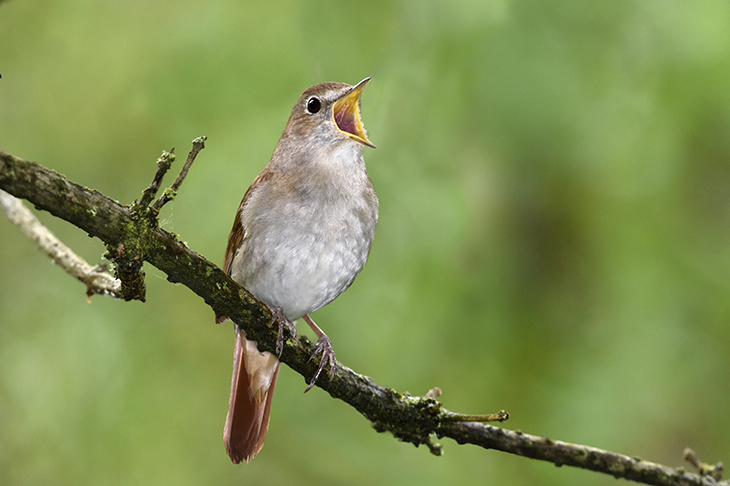In a sense, the song of the bird in the title of this short, hugely thoughtful and fascinating book is a measure of the gap between nature and human culture. On the one hand stands the most mythologised, celebrated and interrogated maker of natural sound on earth: the nightingale. On the other, the most densely populated metropolitan area in western Europe: Berlin.
One might expect our light-winged dryad, in honour of its place in poetry, art, folktale and fiction, to sing in a sylvan glade by a brook full of beaded bubbles. Not a bit of it. It’s by traffic lights in a Berlin park. The bird itself is quite indifferent to the three millennia of cultural churn it has inspired. It is drawn to the German capital by insect biomass and the right vegetation density.
What lies between the two worlds, bridging and speaking to both, is the creature’s song, which has entranced David Rothenberg for many years. And for those who have never heard the species — since it has lost 91 per cent of its UK population in 40 years — it is worth repeating that nightingale song is truly extraordinary. An average male has 250 different song phrases, which it draws together in an unforgettable, spontaneously composed and unrepeatable composition, making each spell of song not only beautiful but unique.
Berlin is apparently among the best places in Europe to hear it. More difficult to fathom is why the song is quite so moving for its human audience. Rothenberg quotes a passage by H.E. Bates, who possibly best captured the paradox at its heart:
It is a performance made up more of silence than of utterance. The very silences have a kind of passion in them, a sense of breathlessness and restraint, of restraint about to be magically broken.
Rothenberg’s recent project has been to fill those nightingale silences with his own improvised clarinet playing. But he does it not in the manner of Beatrice Harrison, the Englishwoman whose cello accompaniments to nightingales in her Kent garden in the 1930s and 1940s formed the BBC’s first ever outside broadcasts. Instead, he creates sounds that are in some equally paradoxical way intended as both a human response to the birds and a genuine duet-forming engagement with non-human music. The staging of these inter-specific concerts is what draws the author to Berlin.
Rothenberg strikes me as bonkers, but also brilliant, and his book expands on this musical challenge to ask key questions relevant to anyone engaged with the natural world. In particular, he goes in search of what he calls the most perfect sound, by which he means non-human music-making, and asks many experts their opinions.
Scientists working on the Berlin birds have even proposed that nightingales have hit on their own version of perfection. This is a short, intense, buzzy phrase which males sometimes insert into their songs and which may be very difficult to achieve, since it requires virtuosic control of the syrinx. It certainly triggers deep sexual excitement among female nightingales.
Rothenberg offers us other versions of audio perfection. One is a competition-winning recording of sounds captured in the Borneo rainforest by the Australian recordist Marc Anderson. I urge you to seek it out: it is a truly magical symphony of bird, insect and amphibian, appearing to be completely natural and yet somehow entirely composed.
Another who adds to the author’s understanding of what makes great bio-acoustics is Lang Elliott, arguably the most brilliant capturer of animal vocalisations in the English-speaking world. Rothenberg notes that while his fellow American is famous for recordings that have a deep sense of purity, Elliott himself insists that the most affecting sounds have to include both the creature and its natural setting. The sense of completeness, of a vocalisation integrated into its environment, is what brings us closest to perfection.
Perhaps the most alarming part of Nightingales in Berlin is the author’s account of conversations with his fellow specialist Gordon Hempton. Unlike Lang Elliott’s, Hempton’s recordings are apparently carefully contrived versions of the natural world. Or, as Rothenberg notes, art rather than nature. One of Hempton’s chief concerns supplies another of the book’s paradoxes: the audio-capturing of silence. In the Anthropocene, this is an increasingly scarce entity. Hempton judges that America now has only nine locations free of the relentless white noise generated by humanity. Europe has none.
But Rothenberg is upbeat, because what motivates his book is the idea that humans and other parts of life can collaborate. Berlin and its nightingales are an example, and weare all the richer for their shared soundscape.
Got something to add? Join the discussion and comment below.
Get 10 issues for just $10
Subscribe to The Spectator Australia today for the next 10 magazine issues, plus full online access, for just $10.
You might disagree with half of it, but you’ll enjoy reading all of it. Try your first month for free, then just $2 a week for the remainder of your first year.














Comments
Don't miss out
Join the conversation with other Spectator Australia readers. Subscribe to leave a comment.
SUBSCRIBEAlready a subscriber? Log in